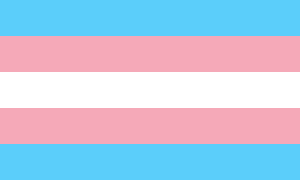Transgender facts for kids

Transgender people are people who identify or feel differently from their assigned sex at birth. It is considered a gender modality in which gender identity differs from the gender assigned at birth.
Contents
Definitions
The word "transgender" may describe many different people. People with different ideas about their genders may think of themselves as transgender. These people use different words to describe their gender. The term "trans people" is often used as a short version of "transgender people".
Some common definitions of the words used in this article are listed here:
- Anatomical (biological) sex means whether someone was born with a male or female body.
- Cisgender is an antonym of transgender and means a person who identifies as the gender they were assigned at birth
- Gender is the way masculinity and femininity are seen or used by all people, separate from anatomical sex.
- Gender expression is how a person behaves or acts in ways that affect how others might view them as being male or female.
- Gender identity is a person's sense in their mind of whether they are a man, woman, something else or neither (agender).
- The gender binary is the idea that a person must be either male or female and that there is no other gender other than those two.
- Gender role is society's view of how people should act because of their gender: men and women are expected to act in a certain way. Gender roles are often enforced by society through disapproval of cross-gender behavior: for example, if a male child wants a doll, he might be told that he is "acting like a girl". If a female child climbs a tree, she might be called a "tomboy".
These definitions are important to help understand that what people look like outside (sex) is not always the same as how they feel inside (gender). Some people do not fit into the gender binary.
Please note that transgender is best used as an adjective. Using the word as a noun can be considered offensive.
Types of transgender people
There are many subgroups of people who are included in the term transgender. Not all transgender people fit into these groups. Some of the big groups are:
- Transsexual – unlike the term 'transgender', this is a more specific term. It is an older word which existed in medical communities and is preferred to be used by people who seek to change their bodies (such as through surgery or hormones). Many people prefer the term "transgender" to "transsexual" and see "transsexual" as an offensive term as it used to refer to the identity as a disease, and clinicians are advised to only use the term "transsexual" if their client is okay with it.
- AFAB – means 'assigned female at birth.'
- AMAB – means 'assigned male at birth.'
- Transgender Woman - assigned male at birth (AMAB) but identifies as a woman. Also called a 'trans woman.'
- Transgender Man - assigned female at birth (AFAB) but identifies as a man. Also called a 'trans man.'
- Genderqueer – is someone who rejects the whole idea of a gender binary and may identify as a number of varied gender terms. Genderqueer people may prefer to use the term "Non-Binary" to describe themselves, which is often shortened to "enby" (from spelling out the acronym "NB" phonetically).
- Transfeminine – a term for any person, binary or non-binary, who was assigned male at birth and has a predominantly feminine gender identity or presentation; transmasculine is the equivalent term for someone who was assigned female at birth and has a predominantly masculine gender identity or presentation.
History
People like those who, in modern Western societies, are now identified as transgender or transsexual, have been documented in many cultures and for thousands of years. However, only in the last century have science and medicine developed ways to change the bodies of trans people who want this.
People who have traits that are different from the sex they are born with, have been accepted in some societies, both historically and now. For example, some Native American tribes accepted two-spirit people. Similarly a Tongan person born with a male body who acts and dresses in a female way is known in the local dialect as a "fakaleiti".
The "hijra" in India are born physically male, but live as women, including dressing and socializing as female. Now, with the arrival of western medicine, many hijari choose to take hormone therapies and sometimes have sex reassignment surgery. Many of these people still call themselves "hijra", but some now call themselves "transsexuals" or "transgender women". The role of hijari in society is complex and varied throughout all of India.
In western society, there have often been people who have chosen to act and dress in a way that was not gender specific, or was not that of the sex they were assigned at birth. This is not the same as being transgender. Cross dressing actors were very popular in the theatre of the late 19th century.
An example of a transgender person is the 19th century military surgeon who was known as James Barry. It is now believed that Barry was born female but disguised his sex all his adult life. Barry's work, which saved, and helped thousands of lives by improving treatment of wounds to stop amputations, would not have been possible, as a woman, because as a female he could never have attended medical school or entered the army.
A 20th century example of a transgender person is Jan Morris, a geographer, explorer and journalist, who began life as James Morris. As "James", Morris married and had children, but felt female and eventually became Jan Morris.
Issues
Transgender people are not accepted by all people and all societies. Transgender people suffer discrimination, violence, and even murder. Transgender people have fought and worked hard to get many rights and protections in some societies. In many places, the fight for transgender rights is associated with the fight for gay and bisexual rights. Together these groups are sometimes described by the acronym LGBT for lesbian, gay, bisexual, and transgender.
However, some transgender people do not want to be a part of the LGB (lesbian, gay and bisexual) community, as they may see themselves as heterosexual and not feel like they belong with gay or queer people, and some LGB people do not want to be a part of the transgender community, as they may be transphobic, which means that they may have a fear or dislike of transgender people. However, gay and transgender people often have some of the same problems in society, so many gay, lesbian, bisexual, and transgender people try to work together to solve all of their problems.
Mental health
Many transgender people have mental health problems. 55% had been diagnosed with depression. 33% had not been diagnosed with depression, but thought that they had it in the past or at the time of the survey. 38% of had been diagnosed with anxiety. 31% were using antidepressants and 44% had used them at some time.
Transgender youth are often depressed because they are bullied by other people, or because they feel very unhappy having their body become an adult body that they do not want because they feel it is the wrong body. Some people (usually social conservatives) say the rates of depression are high because transgender people are mentally ill.
Some studies however have shown that transgender people may have better mental health when they live as their preferred gender.
Medical care
Transgender people who want to take medicine and have surgery to change their bodies face several problems. In order to change their bodies, they must have doctors who will help them make the changes. Sometimes, they can not do this because doctors will not help them. They may also not be able to do this because even if a doctor would treat them, they may not be able to afford the medicine or surgery. But the Declaration of Montreal says that such medical care should be given to them by public health insurance.
Disease versus difference
Some people believe that being transgender is a disease, sometimes called gender identity disorder. Many transgender people do not like being labelled as having a disease, which they feel causes them to be seen and treated badly. Others believe that they should be labelled this way, because some governments and insurance companies will not pay for transgender people's medical treatment unless it is considered a disease. Also, In places that do not have laws that protect transgender people from discrimination, they may only be protected under laws that protect people with diseases or disabilities.
Doctors do not agree on one way of viewing being transgender. Some doctors view it as a birth defect that can easily be fixed, others may not even think that being transgender is a medical condition. Since May 25th, 2019, the World Health Organization does not see being transgender as a disease or mental health problem, asking many countries to comply as well. One of the international human rights laws of the Yogyakarta Principles (Principal 18), disagrees with any use of a medical disease label.
Legal problems
Transgender people have problems with laws and regulations about sex. To be seen and treated as the sex they wish, transgender people usually have to change their first name. (Though some names are unisex, which means that they can be used by both men and women, transgender people with a unisex name may still want to change their name, though this is not always the case.) They also may want to change their identity documents to say the correct sex. For example, a transgender woman may wish to change her birth certificate or driving license to say her new female name and to say that she is a female.
These changes can protect transgender people from discrimination. For example, transgender people often have a hard time traveling because they may look like one sex but have another on their papers. These changes can also be needed for transgender people to be allowed to marry their spouses in places where it is illegal for people of the same sex to marry. These changes can even protect transgender people from a wide variety of violence. Some transgender people are only recognized when their documents reveal them. Being revealed as transgender can put people in danger because of transphobia (fear and/or hatred of transgender people).
In many places, it is hard or not possible for transgender people to change their legal sex, with or without having sexual reassignment surgery, which is required in many places. This is against the Yogyakarta Principles. This is changing, however. The United Kingdom passed the Gender Recognition Act of 2004. This act allows people to have their change of sex officially recognized without surgery. Once changed, they legally become their new sex.[1]
See also
 In Spanish: Transgénero para niños
In Spanish: Transgénero para niños





